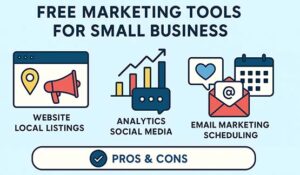INTRODUCTION: The Hidden Trap of Competitive Keywords (and How to Escape It)
Imagine this:
You’ve spent months optimizing for a keyword you thought would bring in leads. You followed SEO best practices, wrote detailed content, built backlinks—but your page is stuck on page 3.
No clicks. No traffic. No ROI.
What went wrong?
The truth is, not all keywords are winnable.
Some keywords are like a locked vault, guarded by industry giants who have spent years (and millions of dollars) securing their rankings. They don’t just have good content—they have entire content silos, an aggressive link-building strategy, and deep SEO resources that make it nearly impossible to break in.
The good news? You don’t need to compete with them.
There’s a faster, smarter way to rank on Google—one that doesn’t involve wasting months chasing keywords you’ll never win. Instead, you can:
✅ Find high-value, low-competition keywords that bring in real traffic.
✅ Rank faster with strategic, targeted content.
✅ Build the authority you need to eventually take on bigger, more competitive keywords.
In this guide, I’ll show you:
- How to identify unwinnable keywords before you waste time on them.
- The step-by-step process to find low-competition, high-impact keywords instead.
- How to build authority over time so you can eventually compete for harder keywords.
Stop chasing impossible rankings. Start winning traffic today.
Let’s dive in.
What Makes a Keyword “Unwinnable”?
Imagine you’re about to climb a mountain. You size up the terrain, check your gear, and determine if it’s within your ability. SEO works the same way—some keywords are an easy hike, while others are steep, ice-covered cliffs that only the most well-equipped climbers can summit.
So how do you recognize when you’re staring up at an SEO Everest? Let’s break it down.
What Is an Unwinnable Keyword?
An unwinnable keyword is a search term that is nearly impossible to rank for without an enormous investment of time, money, and effort. These keywords are often:
✅ Dominated by high-authority sites – Think Wikipedia, Forbes, government websites, or major industry players.
✅ Highly commercial with intense competition – Keywords that signal a buyer’s intent tend to attract companies with deep pockets and aggressive SEO strategies.
✅ Supported by massive SEO budgets – The top results aren’t just great content. They’re backed by thousands of backlinks, a network of related content, and active promotion.
✅ Part of a hyper-competitive “arms race” – When you see the same sites swapping places in the rankings every few weeks, it’s a sign that companies are constantly updating, A/B testing, and optimizing their content to hold their position.
The Hidden Challenges Behind Competitive Keywords
What you see in the search results is just the tip of the iceberg. Behind those top-ranking pages is a full-scale SEO operation designed to protect and reinforce their position. Here’s what’s happening behind the scenes:
🔹 They’re using advanced tools— and not just Ahrefs or SEMrush. They’re running Ahrefs and SEMrush…and Surfer SEO, Link Whisperer, JetOctopus, Clearscope, MarketMuse, and others to analyze every ranking factor.
🔹 They’ve built a content fortress— Each article is part of a well-structured content silo, with supporting articles boosting its authority.
🔹 They’re constantly optimizing— Many high-competition keywords are actively defended, meaning content is rewritten, retested, and A/B split-tested to stay on top.
🔹 They have a network of backlinks— Some of these companies are spending thousands on link-building campaigns each month, securing guest posts, and running outreach campaigns to reinforce their authority.
🔹 They control multiple ranking positions— Many of the top-ranking companies own the search results, running both SEO and paid ads to dominate visibility.
Why Some Keywords Are a Money Pit
Even if you could technically rank for a high-competition keyword, the real question is: Is it worth it?
🔺 Time to Rank: A brand-new page for a high-competition keyword can take 12-24 months (or more) to crack page one—if it ever does.
🔺 Investment Required: You’d likely need dozens of supporting articles, strategic backlink campaigns, and constant optimization to have a fighting chance.
🔺 ROI Uncertainty: Even after all that effort, you might still lose to bigger competitors who can outspend and outmaneuver you. The target might move!
🔺 Better Alternatives Exist: Instead of pouring resources into a losing battle, you could target 10 lower-competition keywords that bring in traffic faster and more reliably.
Real-World Example: Winning vs. Unwinnable Keywords
❌ The Mistake: A small software startup tried to rank for “best CRM software.” They spent months optimizing their content, yet their article never cracked page two. Why? The search results were stacked with billion-dollar companies like Salesforce, HubSpot, and Oracle.
✅ The Smart Pivot: Instead of fighting giants, they targeted “best CRM software for solo consultants”—a long-tail, lower-competition keyword with clear buying intent. Within three months, they hit the top three results, bringing in consistent, targeted traffic with far less effort.
The Bottom Line: Choose Your Battles Wisely
Unwinnable keywords aren’t just “hard.” They are resource drains that keep you stuck in a losing game. Instead of wasting months trying to outrank billion-dollar brands, focus on keywords you can realistically win—the low-competition, high-intent terms that bring in traffic and conversions faster.
In the next section, we’ll break down a simple, free, and fast way to identify unwinnable keywords before you waste time on them.
The Fast & Free Way to Identify Unwinnable Keywords
The good news? You don’t need expensive SEO tools or a paid agency to spot an unwinnable keyword. You can weed them out in minutes using free tools and a quick SERP analysis.
Here’s a simple three-step process to determine if a keyword is worth your time—or if it’s a trap that will drain your resources.
Step 1: Google the Keyword & Analyze the Top Results
Why It Matters: Search engine results pages (SERPs) reveal real-world competition better than any keyword difficulty score.
💡 What to Look For:
🔹 Who’s ranking? If the top spots are owned by major brands, national publications, or government sites, it’s a red flag.
🔹 Are smaller businesses ranking? If you see regional companies, niche blogs, or independent service providers, the keyword may be winnable.
🔹 What types of pages rank? Are the top results product pages, blog posts, listicles, or forums? If the content type doesn’t match what you plan to create, ranking will be harder.
🚀 Example: Searching “best email marketing software”? The top results include HubSpot, Mailchimp, and Capterra. That’s a sign this keyword is heavily dominated by established brands with strong domain authority.
Step 2: Check Content Quality & Gaps
Why It Matters: You don’t need to be the biggest site to rank—you just need to create better, more relevant content than the competition.
💡 What to Look For:
🔹 Is the content truly great? If the top-ranking pages are thin, outdated, or generic, you may have an opening.
🔹 Do they fully answer user intent? If users click back to search for a better answer, that’s a sign of weak content you can outdo.
🔹 Are they using structured formatting? Look for tables, lists, in-depth analysis, or expert opinions. If the top results lack depth, you can outperform them with a well-researched, structured article.
🚀 Example: Searching “how to build a lead magnet”, you find short, vague articles that barely scratch the surface. A detailed, step-by-step guide with templates could easily rank above them.
Step 3: Check Backlinks & Authority (Quick Version)
Why It Matters: The more backlinks and authority a page has, the harder it will be to outrank.
💡 What to Look For:
🔹 Domain Authority (DA): Use Moz’s free DA checker or Ahrefs’ free site explorer to check the authority of the ranking sites. If all results have DA 80+, that’s a warning sign.
🔹 Backlink Profile: Use Ahrefs’ free backlink checker to see how many links point to the top-ranking pages. If they have hundreds of backlinks, the competition is fierce.
🔹 Does your site have a chance? If your site is new with few backlinks, it’s best to target lower-competition keywords first.
🚀 Example: Searching “project management software”, you see that the top-ranking pages have thousands of backlinks from industry publications. Unless you have a massive PR budget, this keyword is out of reach.
Bonus Tip: Spot the Low-Competition Gems
While running this quick analysis, keep an eye out for keywords that are “hidden gems”—low-competition keywords ripe for the taking. These often show up when:
✅ You see smaller blogs or businesses ranking in the top 10.
✅ The content is low quality or outdated, leaving room for better content.
✅ The keyword is niche and specific, making it easier to compete.
✅ There are “People Also Ask” questions you can easily answer.
🚀 Example: Instead of “best marketing automation software”, targeting “best email automation tools for freelancers” could be far easier to rank for while still attracting high-intent traffic.
Final Thought: Focus on What You Can Win Now—Then Scale Up
SEO isn’t about brute-forcing your way to the top. It’s about choosing battles you can win today while building the authority you need to rank for bigger keywords tomorrow.
✅ Start with low-competition keywords that you can rank for quickly and convert into traffic.
✅ Use free tools & SERP analysis to identify winnable vs. unwinnable keywords.
✅ Build momentum first, then target more competitive terms as your site grows in authority.
Next Up: The Smart Strategy to Move Up to More Competitive Keywords
How to Build Authority and Win Bigger Keywords Over Time
You might be thinking, “Okay, I get it—some keywords are just too competitive. But how do I go from winning small battles to conquering the bigger ones?”
The answer: Build your authority strategically.
SEO isn’t just about picking the right keywords—it’s about growing your credibility so that, over time, you can turn today’s unwinnable keywords into tomorrow’s ranking victories.
Here’s the roadmap:
Step 1: Start With “Easy Wins” (Low-Competition Keywords)
Before you try to outrank billion-dollar brands, you need to establish yourself as a credible source.
💡 What to Look For:
✅ Long-tail keywords: These are highly specific, lower-competition keywords that are easier to rank for (e.g., “best email automation tools for solopreneurs” instead of “email marketing software”).
✅ Local or niche-focused keywords: If you’re a service provider, go after geo-targeted keywords (e.g., “roof repair in Austin”).
✅ Keyword gaps: Look for search queries where existing content is weak, outdated, or incomplete.
🚀 Example: A brand-new fitness coach shouldn’t try to rank for “best diet plan” right away. But “best post-pregnancy diet for new moms”? That’s a highly specific niche with lower competition.
🛠 Helpful Resource: Learn more about the power of long-tail keywords in What Are Long-Tail Keywords, and Why Are They a Game Changer?
Step 2: Build Topic Authority With Content Clusters
Google doesn’t just rank pages—it ranks trusted authorities on a subject.
The fastest way to become an authority? Create a content hub.
🔹 How It Works:
1️⃣ Pick a broad, competitive topic (e.g., SEO for local businesses).
2️⃣ Identify subtopics that are less competitive (e.g., how to optimize a Google Business Profile).
3️⃣ Create multiple articles covering those subtopics, all linking back to your main “pillar” page.
This hub-and-spoke model tells Google: “This site knows everything about this topic.”
🚀 Example: Instead of trying to rank for “how to get more Google reviews” immediately, create supporting content:
✅ “Best Review Request Templates for Local Businesses”
✅ “How to Handle Negative Reviews Without Hurting Your Reputation”
✅ “Why Google Reviews Matter for Local SEO”
By building supporting content, your pillar page on Google reviews gets stronger—and so does your ability to rank for more competitive terms.
🛠 Helpful Resource: Learn more about content clusters in SEO Isn’t Just About Keywords—Why the Hub & Spoke Model Is Essential
Step 3: Earn Backlinks the Smart Way
Backlinks (links from other sites to yours) are one of the biggest ranking factors. The more quality backlinks you have, the stronger your authority becomes.
🔹 How to Get Them (Without Spammy Tactics):
✅ Create data-driven or unique content that others will reference.
✅ Write guest posts for industry blogs in exchange for a link.
✅ Leverage existing relationships—ask suppliers, partners, or customers to link to your site.
✅ Submit your business to directories (especially for local SEO).
✅ Use “linkable assets” like infographics, case studies, and expert roundups.
🚀 Example: A local contractor might create a “Homeowner’s Guide to Hurricane-Resistant Roofing”—an evergreen resource that industry blogs, insurance companies, and home improvement sites would naturally link to.
Step 4: Use Paid Ads to Test Before You Invest in Competitive Keywords
Want to shortcut your learning curve and know which keywords convert before you invest months in ranking for them? Run paid ads.
🔹 How It Works:
✅ Run a Google Ads campaign targeting a high-competition keyword.
✅ See which keywords drive real leads or sales—those are worth pursuing in SEO.
✅ Use that data to guide your content and SEO strategy.
🚀 Example: A personal injury lawyer might think “car accident lawyer” is the best keyword—until a test ad shows that “hit-and-run lawyer near me” converts 3x better with lower competition.
🛠 Helpful Resource: Learn how to validate keywords in What Is Paid Ad ‘Validation’ for Keywords, and How Does It Work?
Step 5: Level Up to More Competitive Keywords Over Time
As your site gains authority, keywords that were once “unwinnable” become realistic targets.
💡 Signs You’re Ready to Compete for Bigger Keywords:
✅ Your domain authority has increased (use Moz’s free DA checker to track).
✅ You’re ranking well for multiple long-tail keywords in your niche.
✅ Your content is getting organic backlinks (other sites are naturally linking to you).
✅ You’ve established topic authority with a content cluster.
🚀 Example: A personal finance blog that started with “best budgeting tips for students” can now scale up to go after “best budgeting apps” or “how to save money fast.”
Final Thought: SEO Is a Marathon, Not a Sprint
Winning competitive keywords isn’t about luck—it’s about playing the long game.
✅ Start with low-competition keywords that bring fast wins and traffic.
✅ Use content clusters & backlinks to build authority.
✅ Validate your keyword choices with paid ads to avoid wasted effort.
✅ Gradually target bigger keywords as your credibility grows.
The SEO “arms race” is real, but you don’t have to fight on someone else’s battlefield. Play smart, build strategically, and soon you’ll be ranking for the keywords that once seemed impossible.
How to Find Low-Competition Keywords (That Actually Lead to Customers)
At first, low-competition keywords seem like a goldmine. You find a keyword with high search volume and barely any competition, and it looks like an easy win.
But if no one else is targeting it, there’s a reason.
Most often, it’s because that keyword doesn’t convert.
A keyword can have all the traffic in the world, but if the people searching aren’t ready to buy, it won’t generate leads or sales. That’s why high-traffic, low-competition keywords exist—because experienced SEOs have already figured out they don’t pay off.
But that doesn’t mean all low-competition keywords are worthless. You just need to know how to find the ones that actually lead to customers.
The process is simple:
✅ Find keywords with clear search intent.
✅ Analyze the SERPs for weak competition.
✅ Look for signs of commercial value.
✅ Test before you invest.
Let’s break it down.
Step 1: Start with Google’s Built-In Keyword Clues
Google wants to tell you what people are searching for. You just have to look in the right places:
✅ Google Autocomplete – As you type, Google suggests related searches that real users type in.
✅ People Also Ask (PAA) Boxes – These reveal related questions users commonly search for.
✅ Related Searches (Bottom of SERP) – More variations Google thinks are relevant.
🚀 Example:
If you start with “roof repair” and see autocomplete suggestions like:
- “roof repair cost per square foot”
- “DIY roof repair for leaks”
That tells you people are looking for cost information or DIY solutions. If your business sells roof repair services, those searches might not convert—people searching them are looking to avoid hiring a pro.
But if you see:
- “best roofing contractors near me”
- “emergency roof repair phone number”
Those indicate buying intent—making them worth targeting.
🛠 Helpful Resource: If you’re new to search intent, check out What Is Search Intent (and Why Does It Matter for Service Businesses)?
Step 2: Analyze the SERPs for Weak Competitors
Just because a keyword looks competitive doesn’t mean it actually is.
💡 Here’s how to spot easy wins:
1️⃣ Google your target keyword and scan the first page.
2️⃣ Look for low-authority sites (small blogs, forums, Quora, Reddit).
3️⃣ Check if the top-ranking pages lack depth (thin content, outdated info).
If you see weak or non-specialized content ranking, Google is still looking for a better answer.
🚀 Example:
You Google “best email marketing strategies” and the top results include:
- A random discussion forum post.
- A 500-word blog from 2017.
That means a new, high-quality post could easily outrank them.
But if the SERPs are filled with:
- HubSpot, Mailchimp, and major SaaS companies.
- Expert-written guides with 3,000+ words.
That’s a highly competitive space—better to look for a niche variation instead.
Step 3: Find Long-Tail Keywords That Big Brands Ignore
Big brands usually chase broad, high-volume keywords. That leaves long-tail keywords wide open for you.
🔹 How to Find Them:
✅ Use Google Autocomplete + “vs” or “best” (e.g., “best budgeting apps for freelancers”).
✅ Check Amazon & Reddit for niche phrases people actually use.
✅ Use AnswerThePublic to find question-based searches.
🚀 Example:
A personal trainer won’t rank for “weight loss tips” against WebMD.
But “best weight loss exercises for busy moms”?
That’s a long-tail, low-competition keyword with clear intent.
🛠 Helpful Resource: Read What Are Long-Tail Keywords, and Why Are They a Game Changer?
Step 4: Use a Free Keyword Tool for Basic Metrics
Now that you have real keyword ideas, use a free tool to check basic metrics.
🔹 Good Free Options:
✅ Google Keyword Planner (search volume & competition).
✅ Ubersuggest (basic keyword difficulty & search volume).
✅ Ahrefs Free Keyword Generator (difficulty & backlinks).
💡 What to Look For:
✔ Search volume of 100–1,000 (not too big, not too small).
✔ Keyword difficulty under 30 (on most tools).
✔ Clear commercial intent (people searching are ready to take action).
🚀 Example:
If “best running shoes” has a KD of 80, but “best running shoes for flat feet under $100” has a KD of 20, which one should you target?
Step 5: Test Before You Invest with Google Ads
Traffic means nothing if it doesn’t turn into leads or sales.
The fastest way to see if a keyword is worth targeting? Run a short Google Ads test.
🔹 How to Do It:
✅ Spend $50–$100 on Google Ads targeting the keyword.
✅ See if it drives real leads, email signups, or sales.
✅ If it converts well, that’s a keyword worth pursuing with SEO.
🚀 Example:
A moving company wants to rank for “long-distance movers.” Instead of investing months in SEO, they test it with a small ad campaign first. If it brings in calls & quotes, they double down with SEO.
🛠 Helpful Resource: Learn how to validate keywords before investing in SEO in What Is Paid Ad ‘Validation’ for Keywords, and How Does It Work?
Bonus Tip: “Zero Search Volume” Keywords Can Be Hidden Goldmines
Some of the best low-competition keywords don’t even show up in keyword tools.
💡 Why? SEO tools can’t track everything—especially emerging trends, niche topics, or hyper-specific searches.
🔹 Where to Find Them:
✅ Look in your customer emails & FAQs (what are people asking over and over?).
✅ Check social media & forums (Reddit, Facebook groups, niche communities).
✅ Scan support tickets or blog comments (see what’s missing in existing content).
🚀 Example:
If a wedding photographer notices couples asking “How do I get great wedding photos if I’m camera shy?”—that’s a perfect content opportunity (even if no SEO tool shows search volume).
Key Takeaways
✅ SEO success starts with winnable keywords.
✅ Use Google’s own search suggestions before relying on keyword tools.
✅ Look at search results, not just numbers. If low-authority pages are ranking, you have an opportunity.
✅ Long-tail keywords are your best friend. They’re specific, lower competition, and highly targeted.
✅ Test before you invest. Running a small paid ad campaign can confirm whether a keyword actually converts before you spend months ranking for it.
✅ Don’t overlook “zero search volume” keywords. Some of the best content ideas don’t even show up in SEO tools.
The best part? This entire process is free. No need for fancy SEO tools—just a smart strategy and a willingness to dig deeper than your competitors.
Final Thought: Start Smart, Build Momentum, and Scale Up
Winning at SEO isn’t about brute force—it’s about strategy. Instead of wasting months chasing unwinnable keywords, focus on what you can rank for now and use those wins to build long-term momentum.
Key Takeaways:
✅ Not all keywords are worth pursuing—some are SEO money pits that will drain your time and resources.
✅ The best opportunities lie in low-competition, high-intent keywords that bring in real traffic and conversions.
✅ You don’t need expensive SEO tools—a smart SERP analysis and strategic keyword selection will set you on the right path.
✅ Start small, win early, and use those wins to grow into more competitive spaces over time.
What’s Next? Take Action Now:
🚀 Audit your current keywords—Are you going after winnable terms or chasing impossible rankings?
🚀 Apply the fast, free keyword-checking process—Use Google SERP analysis to identify keywords you can actually rank for.
🚀 Start building authority now—Even small wins compound over time, preparing you for bigger opportunities ahead.
This is just the first step in your SEO journey. But what happens when you’re ready to move up the ladder—when your site has gained authority, and it’s time to go after those bigger, more competitive keywords?👉 That’s exactly what we’ll cover in Part 2: “When and How to Move Up to Bigger Keywords.”









